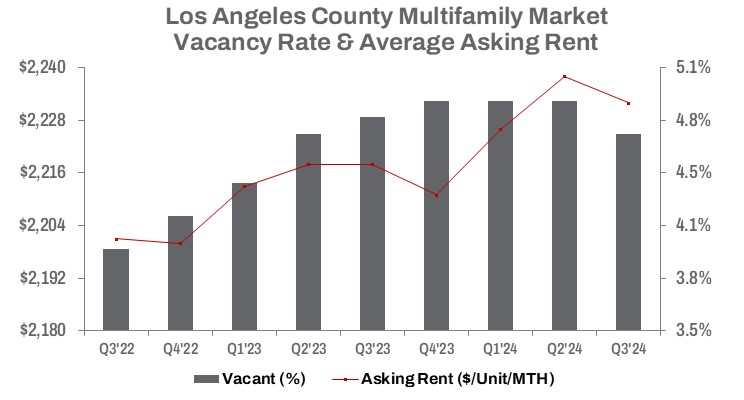L.A. County’s Multifamily Market Navigates Cooling Rents, Lower Vacancy, and Shifting Investment Dynamics
Moderating rents, construction, and elevated costs reshape the multifamily landscape.
Investors manage tax impacts, market uncertainties, and evolving tenant demand.

Managing Director of Research and Public Relations at NAI Capital Commercial
MARKET OVERVIEW
In Q3 2024, average asking rent in the multifamily sector dipped 0.3% quarter-over-quarter but remained 0.6% higher year-over-year at $2,232 per unit per month. New construction played a role, with units built since 2020 seeing rents fall, on average, by $50 from the last quarter and $34 year-over-year, averaging $3,241 per unit per month, indicating the rental market showed signs of a cooling effect from the added inventory to the multifamily housing rental market. Of the 65,809 units delivered since 2020, 8,510 remain vacant, reflecting a 13.1% vacancy rate for these new units in Los Angeles County. However overall, in Q3 2024, the multifamily sector experienced a tick down in the vacancy rate, inching down 20 basis points quarter-over-quarter and 10 basis points year-over-year to 4.7%. Apartment vacancy peaked at a record 5.7% in Q3 2020 but is now declining as high-end supply is slowly absorbed, creating opportunities in the more affordable rental market.
High interest rates, elevated construction costs, and slower rent growth continue to challenge multifamily investment, with the ULA Tax adding additional pressure. Additionally, rents easing from historic highs have brought pricing concerns for both buyers and sellers into focus, impacting transaction volume.
The number of units sold in Q3 declined by 10.4% from the previous quarter, totaling 18,784 units, though year-to-date sales are up 19.7%. The median sale price dropped 4.5% quarter-over-quarter and 6.0% year-over-year to $268,571 per unit. While sales volume increased 47.9% from the prior quarter, the year-to-date rise was a modest 3.2%, representing close to $4.4 billion. The average capitalization rate also rose 50 basis points quarter over quarter and 60 basis points year over year, now at 5.4%, as investors navigate price discovery in an evolving market.
TRENDS TO WATCH
Elevated interest rates continue to drive up borrowing costs, limiting investment and homeownership, which benefits the rental market. Developers are scaling back construction amid rising expenses and slower rent growth projections. By the end of Q3 2024, 2,930 units were completed, reflecting a 25% decline from the previous quarter and bringing the year-to-date total down 29.7% compared to the same period last year, signaling future supply constraints as vacancy rates begin to fall after years of growth.
These supply challenges, along with fading pandemic effects, are reshaping demand for multifamily housing in Los Angeles County. Investment sales have also been affected by taxes and government fees, particularly Measure ULA, the property transfer tax implemented in Los Angeles on April 1, 2023. Originally dubbed the ‘Mansion Tax,’ it imposes a 4% tax on sales over $5 million and 5.5% on those above $10 million, with thresholds adjusted to $5.15 million and $10.3 million in mid-2024. Consequently, year-to-date multifamily sales of assets above the $5 million threshold declined 37% year-over-year, falling nearly $2 billion short of last year’s total.
The multifamily sector investment faces slower growth due to borrowing and operational costs, increasing financial risks. However, demand remains strong for select asset classes, particularly outside the City of Los Angeles.
Looking ahead, investors are wary of Proposition 33, which seeks to repeal the Costa-Hawkins Rental Housing Act and expand rent control across California. While proponents argue that the measure would strengthen tenant protections, opponents warn it could exacerbate the housing shortage by discouraging development and lowering property values. If passed, it would allow cities to impose rent control on a broader range of housing, including single-family homes and newer apartments, significantly impacting Los Angeles County’s multifamily market.
LOS ANGELES COUNTY MULTIFAMILY MARKET STATISTICS Q3 2024



































































